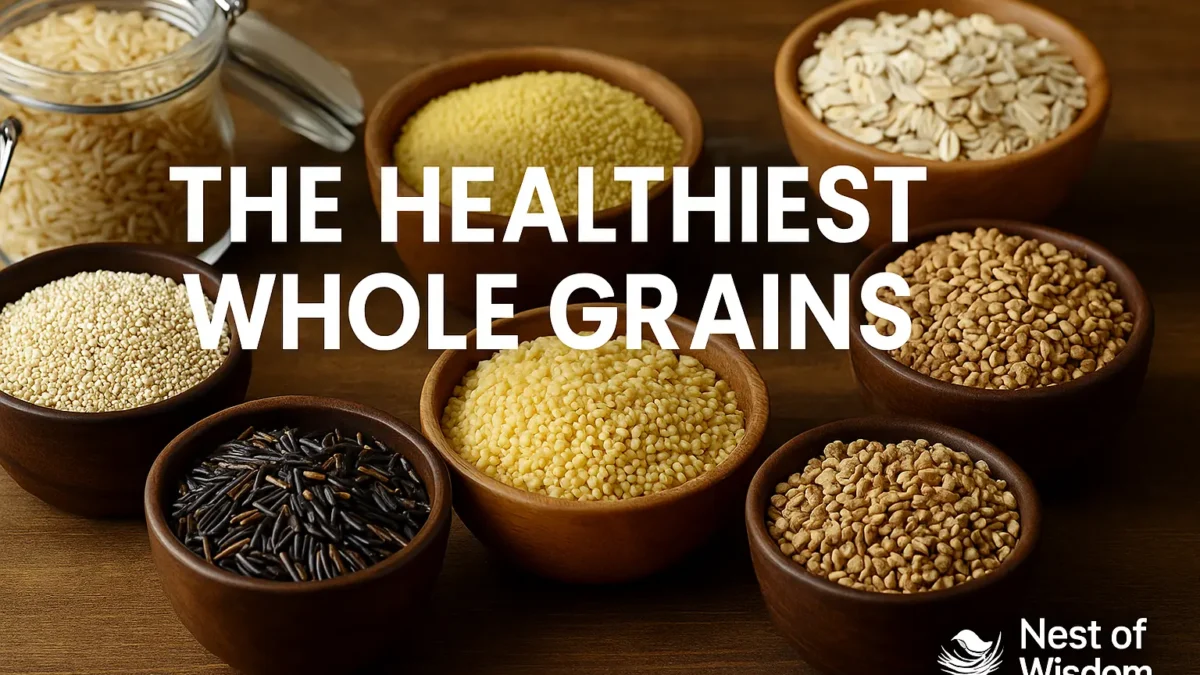Healthiest whole grains give you steady energy, gentler digestion, and real weight-management help without fad rules. When you swap refined carbs for truly whole, minimally processed grains, you add fiber, magnesium, and B-vitamins that keep you satisfied. This guide ranks the healthiest whole grains, shows how to cook them well, and shares Tamil home tips to make the shift feel natural. Educational only — not medical advice.
தமிழில்: முழுத்தானியங்கள் குடல் ஆரோக்கியத்தையும் நீண்ட நேர பசியணைக்கும் சக்தியையும் தரும். மெதுவாக மாற்றி பழகினால் உடல் எடை சமநிலையிலும் உதவும்.
Table of Contents
- Why the healthiest whole grains matter now
- How we ranked the healthiest whole grains
- Quick comparison table (fiber, GI, easy uses)
- The 7 Healthiest Whole Grains (profiles, Tamil tips)
- Science snapshot: what research says
- The plate method & portions
- Fiber & microbiome benefits
- Soak, sprout & ferment — digestibility
- Budget, storage & label reading
- 5 quick everyday recipes
- Simple 5-day whole-grain plan
- Who benefits most (and cautions)
- FAQs on the healthiest whole grains
- Internal Links
- References
- Conclusion
Why the healthiest whole grains matter now
Refined flours dominate modern plates, but they digest quickly and can spike blood sugar. In contrast, the healthiest whole grains keep the bran and germ—the parts rich in fiber, minerals, and phytochemicals. That combo supports satiety, regularity, and heart health. For many families, this is the easiest, most sustainable upgrade you can make—no extreme rules, just better staples.
தமிழ் நினைவூட்டு: “முழுதானியமே முதன்மை”—பசியை நீண்ட நேரம் கட்டுப்படுத்தும்.
How we ranked the healthiest whole grains
- Fiber density: grams of fiber per cooked cup (approximate).
- Glycemic impact: lower to moderate GI helps stable energy.
- Micronutrients: magnesium, iron, zinc, manganese, B-vitamins.
- Digestive ease & versatility: how friendly and flexible it is in real home cooking.
- Gluten-free options: choices for those who need them.
Note: Nutrition varies by brand, variety, and cooking method. Use these as practical averages—not absolutes.
Quick comparison table (fiber, GI, easy uses)
| Whole grain | Fiber (per cooked cup) | Approx GI | Quick uses |
|---|---|---|---|
| Quinoa | ~5 g | ~53 | Bowls, salads, pulao |
| Brown rice | ~3.5 g | 50–66 | Rice plates, stir-fries |
| Oats (rolled/steel-cut) | ~4 g | ~55 | Porridge, overnight oats |
| Millets (foxtail/little/kodo) | ~5–8 g | ~35–54 | Upma, pongal, dosai |
| Barley | ~6 g | ~28–35 | Soups, salads, barley water |
| Buckwheat | ~4.5 g | ~49 | Porridge, pancakes |
| Wild rice | ~3 g | ~45 | Mixed rice bowls, soups |
The 7 Healthiest Whole Grains (profiles, Tamil tips)
1) Quinoa — The Complete Protein (கீனோவா)
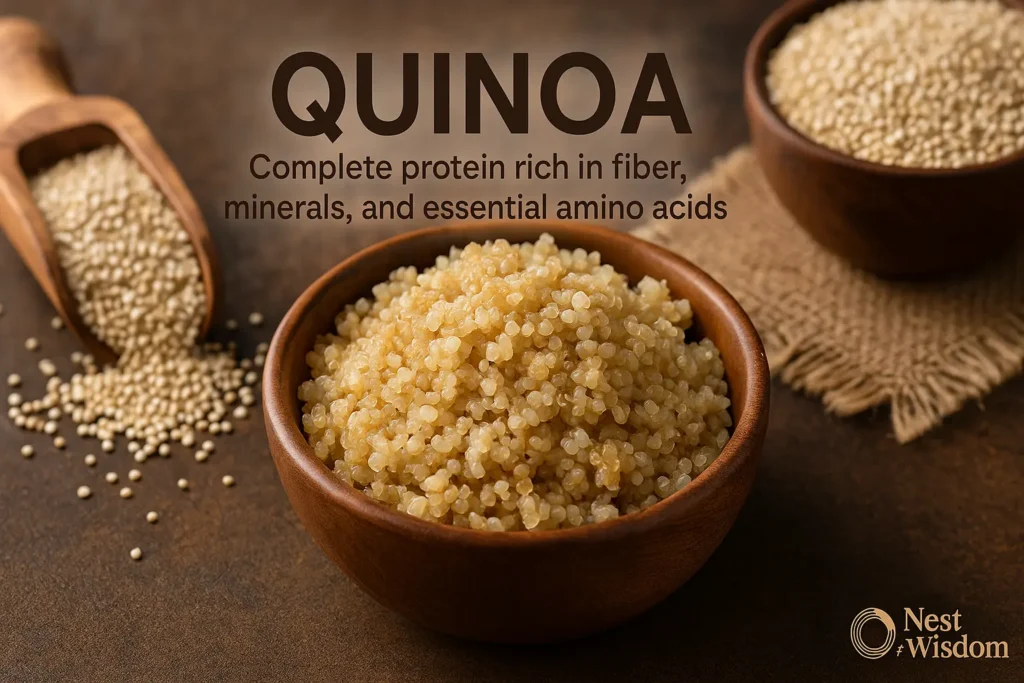

Technically a seed, quinoa cooks like a grain and contains all nine essential amino acids—rare among plant staples. It’s a star among the healthiest whole grains for vegetarians, diabetics seeking steady energy, and anyone rotating away from wheat.
- Highlights: ~5 g fiber/cup; magnesium-rich; lower GI; naturally gluten-free.
- Prep: rinse well to remove saponins; 1:2 quinoa:water; fluff.
- Ideas: lemon-herb quinoa, quinoa-curd bowl, veg quinoa pulao.
தமிழ் டிப்: கீனோவாவை இறுதியில் எலுமிச்சைச் சாறு + கீரை சேர்த்தால் ருசியும் செரிமானமும் உயரும்.
2) Brown Rice — Classic Bran Power (முற்றிய அரிசி)
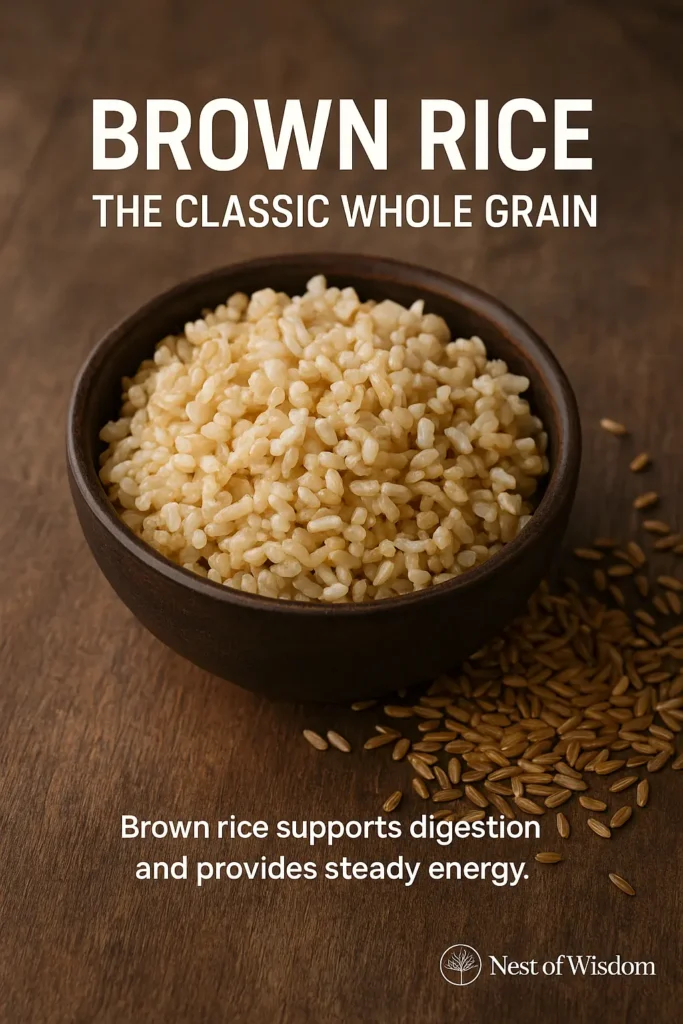

Unpolished rice keeps its fiber-rich bran and the nutrient-dense germ. As one of the healthiest whole grains for everyday plates, it supports fullness, mineral intake, and more stable blood glucose compared to white rice.
- Highlights: ~3.5 g fiber/cup; B-vitamins, magnesium, selenium.
- Prep: soak 4–6 h; 1:2 rice:water; rest 5–10 min after cooking.
- Ideas: sambar rice with veggies, brown-rice stir-fry, curd rice with grated carrot.
தமிழ் அறிவுரை: நீரில் ஊறவைத்தால் மென்மையாய் சமைத்து செரிமானமும் எளிதாகும்.
3) Oats — The Heart Helper (ஓட்ஸ்)
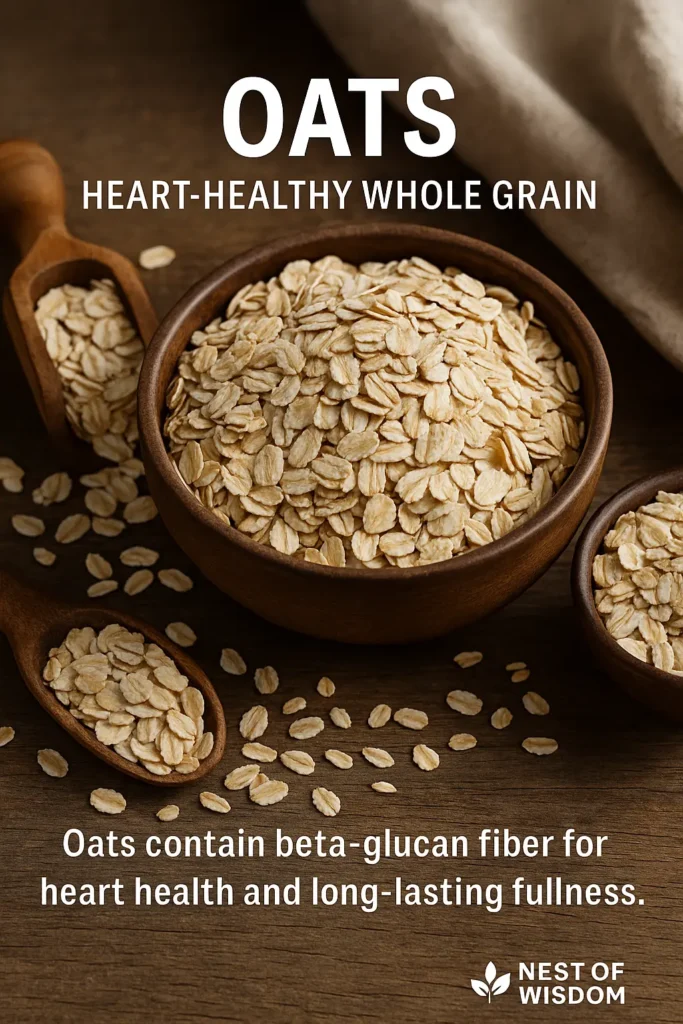

Beta-glucan soluble fiber in oats helps lower LDL cholesterol and keeps you full. For many families exploring the healthiest whole grains, oats are the easiest warm breakfast swap.
- Highlights: ~4 g fiber/cup; ~6 g protein; GI ~55.
- Types: steel-cut (chewy), rolled (balanced), instant (higher GI).
- Ideas: oats porridge with pear + flax; savory oats upma with veggies.
தமிழ் டிப்: ஓட்ஸில் கறிவேப்பிலை/இஞ்சி தாளித்து உப்புமாவாக செய்தால் ருசி + செரிமானம்.
4) Millets — India’s Forgotten Superfood (சிறுதானியங்கள்)
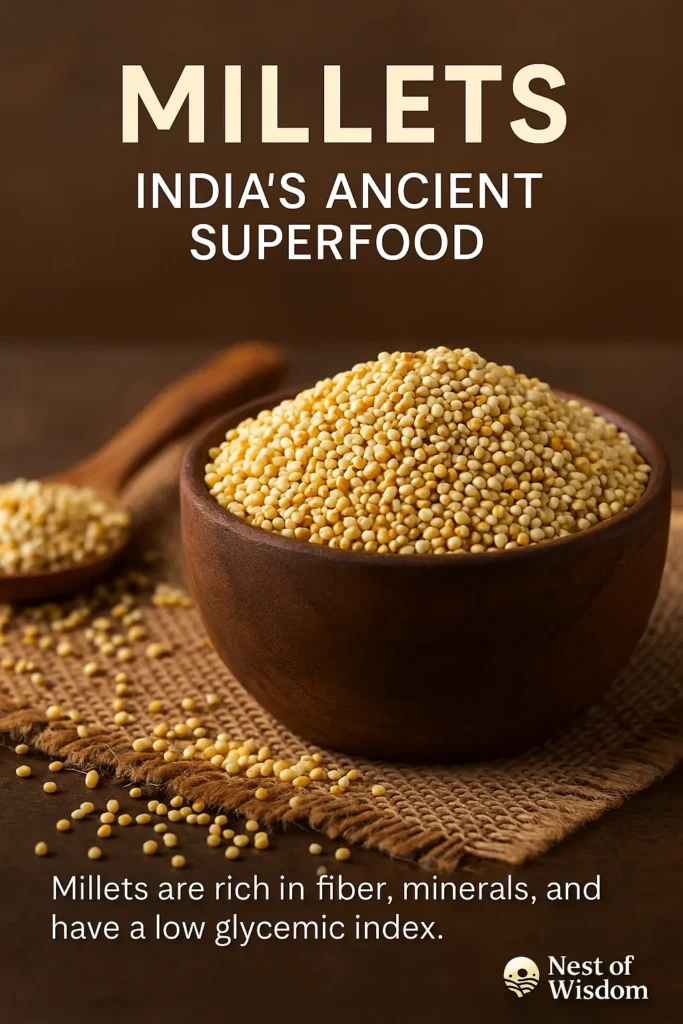

Foxtail (திணை), kodo (வரகு), little millet (சாமை) are fiber-dense, lower-GI staples. As some of the healthiest whole grains for South Indian kitchens, they fit seamlessly into upma, pongal, idli/dosa batters, and mixed rice bowls.
- Highlights: ~5–8 g fiber/cup; often lower GI; mineral-rich; gluten-free.
- Prep: rinse + soak 4–8 h; cook 1:2–1:3 millet:water.
- Ideas: samai veg upma, thinai lemon rice, varagu pongal.
தமிழ் ஞானம்: சிறுதானியங்கள் வாரத்திற்கு 3–4 நாட்கள் போதும்; அரிசி/கோதுமையுடன் சுழற்றி பயன்படுத்துங்கள்.
5) Barley — The Digestive Strengthener (பார்லி)
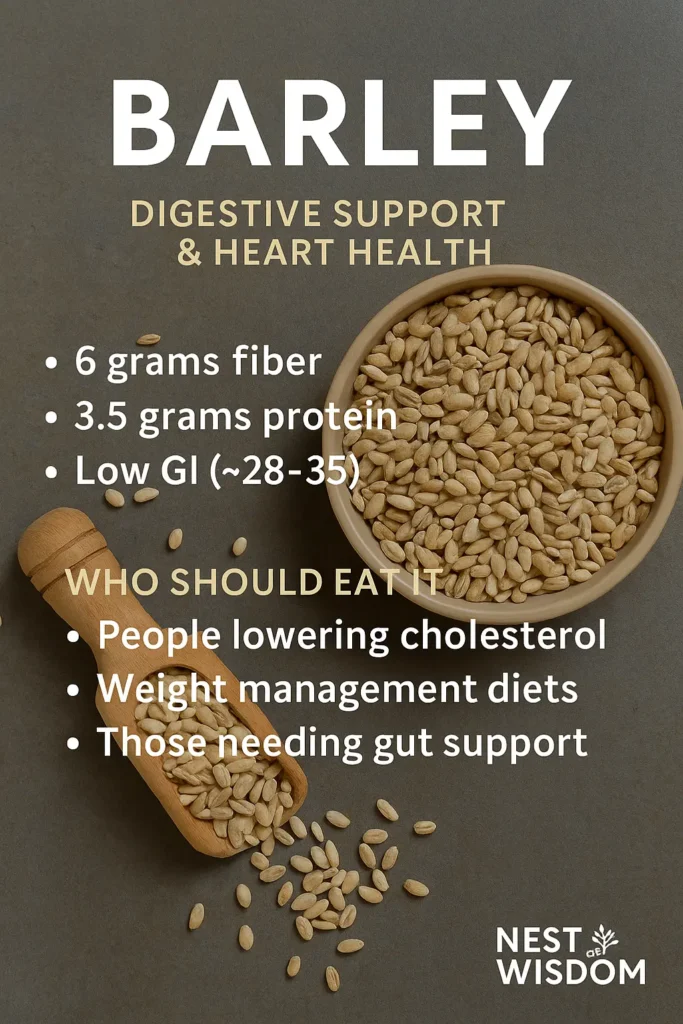

Barley’s beta-glucan supports cholesterol and satiety, while its texture holds up in soups and salads. Among the healthiest whole grains for weight management, it delivers fullness with a friendly flavor.
- Highlights: ~6 g fiber/cup; low–moderate GI; minerals.
- Prep: pearl barley cooks faster; 1:3 barley:water ~45 min.
- Ideas: barley-veg soup, lemon barley salad, homemade barley water.
தமிழ் டிப்: கோடை நாட்களில் பார்லி வாட்டர் குளிர்ச்சியும் நீரேற்றமும் தரும்.
6) Buckwheat — The Gluten-Free Warrior (பக்க்வீட்)
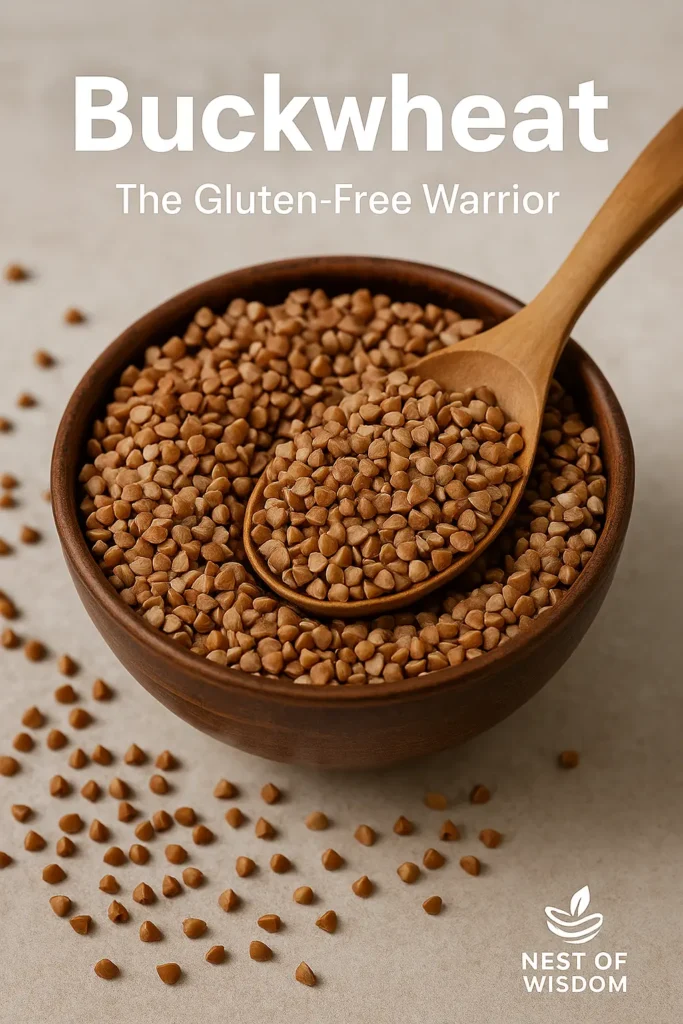

Unrelated to wheat, rich in rutin and minerals, buckwheat is versatile in dosai/pancakes or porridge. If you need gluten-free options among the healthiest whole grains, this one earns a place in rotation.
- Highlights: ~4.5 g fiber/cup; moderate GI; antioxidants.
- Prep: lightly toast groats to remove raw taste; cook 1:2.
- Ideas: buckwheat porridge with nuts; buckwheat dosai.
தமிழ் குறிப்பு: ஆரம்பத்தில் சிறு அளவில் தான்—சுவை/செரிமானம் பழகும்.
7) Wild Rice — The Chewy Ancient Seed
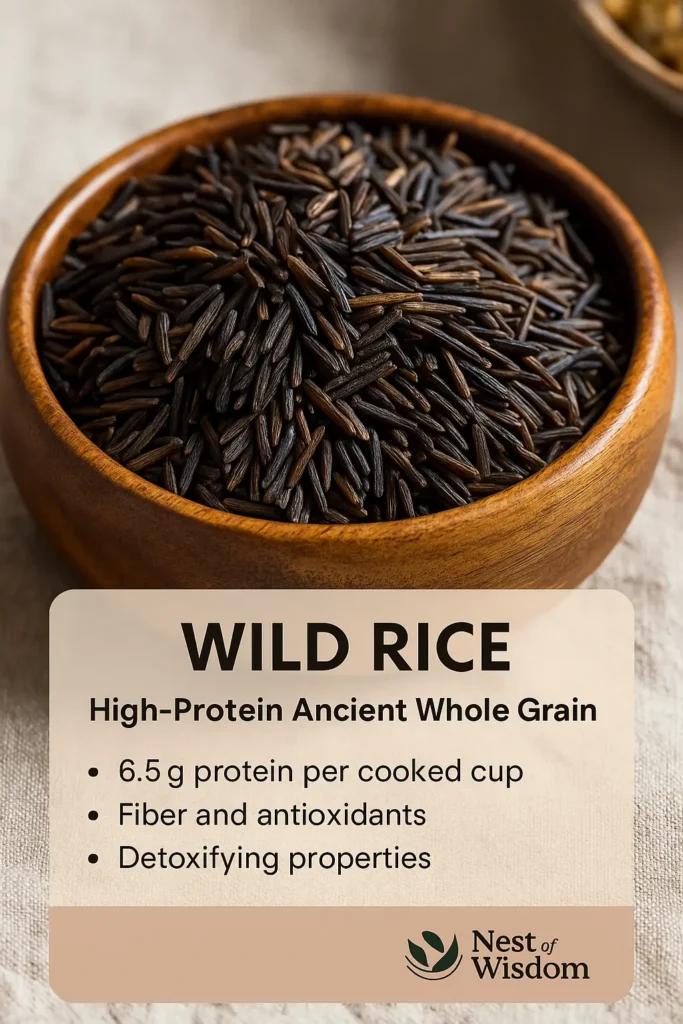

Technically a grass seed, wild rice brings protein, antioxidants, and a satisfying bite. In a shortlist of the healthiest whole grains, it shines in soups and mixed bowls.
- Highlights: ~3 g fiber/cup; ~6.5 g protein; GI ~45.
- Prep: rinse; simmer 1:3 ~50 min until grains split.
- Ideas: wild-rice–veg soup; wild rice + chana bowl.
தமிழில்: நன்றாக சமைக்காவிட்டால் கடினமாக இருக்கும்—சற்று நேரம் கூடுதல் கொடுங்கள்.
Science snapshot: why the healthiest whole grains work
Large population studies consistently link higher whole-grain intake with better metabolic and heart outcomes. Fiber slows glucose absorption and feeds gut microbes; beta-glucans in oats and barley help lower LDL; minerals like magnesium support insulin sensitivity. While no single food is a cure, building meals around the healthiest whole grains contributes to lower cardiometabolic risk when combined with vegetables, pulses, and active living.
தமிழ் சுருக்கம்: முழுத்தானியங்கள்—சர்க்கரை கட்டுப்பாடு, இதய ஆரோக்கியம், குடல் நுண்ணுயிர்கள்—மொத்தத்தில் நல்ல பலன்கள்.
The plate method & portions (using the healthiest whole grains)
- Half plate: non-starchy veggies (keerai, beans, cabbage, bhindi).
- Quarter plate: healthiest whole grains (½–1 cup cooked).
- Quarter plate: protein (dal, chana, fish, paneer, egg).
- Fats: 1–2 tsp oil/ghee; add nuts/seeds for crunch.
Hand guide: a closed fist ≈ ¾–1 cup cooked grain; palm ≈ protein; two palms ≈ veggies. Combine protein + fat with the healthiest whole grains to blunt glucose spikes (glycemic load matters more than GI alone).
Fiber & microbiome: how the healthiest whole grains help your gut
Grain fibers include insoluble fiber (adds bulk, speeds transit) and soluble fibers like beta-glucan (forms a gentle gel, binds bile acids). When these fibers reach the colon, microbes ferment them into short-chain fatty acids (SCFAs) like butyrate—fuel for colon cells linked to calmer inflammation and better barrier function. That’s one reason the healthiest whole grains often ease irregularity over a few weeks.
தமிழ் டிப்: நீரை சீராக குடியுங்கள் (2.5–3 லிட்டர்/நாள்); நாருடன் நீர் தான் வேலை செய்யும்.
Soak, sprout & ferment — making the healthiest whole grains gentler
- Soak 4–8 h: softens bran, reduces cook time; drain, rinse, then cook.
- Sprout (optional): 12–24 h for millets/buckwheat; boosts some B-vitamins.
- Ferment: idli/dosa batters using millets + urad encourage friendly microbes and easier digestion.
- Salt late: add near the end so outer layers don’t toughen.
தமிழில்: ஊறவைத்து சமைத்தால் மென்மை, ருசி, செரிமானம்—மூன்றிலும் முன்னேற்றம்.
Budget, storage & label reading
- Bulk buy & rotate: pick 2–3 of the healthiest whole grains per month; store in airtight jars away from heat/light.
- Freezer trick: cook big batches; cool fast; portion and freeze; reheat with a splash of water.
- Labels: look for “100% whole grain,” not just “multigrain.” Watch added sugars/syrups in “instant” products.
- Whole Grain Stamp (48g): a quick cue brands use to signal genuine whole-grain content.
5 quick everyday recipes (using the healthiest whole grains)
- Thinai Lemon Rice (15 min): Cook foxtail millet; temper mustard, curry leaves, green chilli; add turmeric, lemon juice, peanuts; fold millet. தமிழ்: எலுமிச்சைச் சாறு இறுதியில்.
- Oats Upma: Dry-roast rolled oats; sauté onion, veggies; add water 1:1; steam till fluffy; finish with lemon + coriander.
- Quinoa Curd Bowl: Quinoa + curd + grated cucumber + salt; tadka with mustard/curry leaves; top with pomegranate.
- Barley-Veg Soup: Sauté garlic/onion/carrots; add barley + water/stock; simmer; finish with pepper + lemon.
- Buckwheat Dosai: Soak buckwheat groats 2–3 h; blend with little urad + methi; ferment; make thin dosai.
Simple 5-day whole-grain plan
Keep the healthiest whole grains in rotation without boredom. Adjust for appetite and goals.
- Day 1: Breakfast oats porridge (pear + flax) • Lunch brown-rice sambar + poriyal • Dinner millet upma + curd • Swap: guava.
- Day 2: Quinoa lemon rice + peanuts • Lunch chapati + chana masala • Dinner barley-veg soup + salad • Swap: buttermilk.
- Day 3: Millet pongal + chutney • Lunch wild-rice veg bowl • Dinner quinoa-curd bowl + cucumber • Swap: soaked raisins.
- Day 4: Buckwheat dosai • Lunch brown-rice rasam + keerai kootu • Dinner oats upma + veg raita • Swap: roasted chana.
- Day 5: Steel-cut oats (savory) • Lunch barley salad + moong sundal • Dinner thinai lemon rice + egg/Paneer • Swap: fruit with peel.
தமிழ் டிப்: சாப்பாட்டிற்கு பின் 10–15 நிமிடம் மெது நடை—செரிமானம் சீராகும்.
Who benefits most (and cautions)
- Benefits: people with sluggish digestion, weight goals, high cholesterol, prediabetes/diabetes, athletes seeking steady fuel—the healthiest whole grains help with satiety and consistency.
- Go slow: increase fiber gradually; drink water consistently.
- Gluten note: oats may be cross-contaminated—choose certified GF if sensitive; barley contains gluten; buckwheat/millets/quinoa/wild rice are GF.
- Medical care: red flags (bleeding, persistent pain, weight loss) need clinician review.
FAQs on the healthiest whole grains
1) Which are best for diabetes?
Millets, barley, oats, and quinoa provide fiber and lower to moderate GI. Pair with protein/veg and portion sensibly.
2) Are millets better than wheat for weight loss?
Often yes—they’re fiber-dense, naturally gluten-free, and very satiating. Rotate with brown rice and quinoa.
3) Can whole grains cause bloating?
Rapid increases can. Soak when possible, chew well, and scale up over 1–2 weeks with steady hydration.
4) What’s the easiest first swap among the healthiest whole grains?
Breakfast oats or brown rice in place of white rice are practical starts. Quinoa bowls are a close second.
5) Do kids and elders tolerate these grains?
Yes—start with softer textures (oats, well-cooked brown rice, millets) and modest portions. Flavor with ginger/lemon/ghee for comfort.
6) Are “multigrain” products the same as whole grain?
Not necessarily. “Multigrain” can still be refined. Look for “100% whole grain” and check the fiber per serving.
7) Night meals: are whole grains okay at dinner?
Yes—keep portions modest and pair with veggies/protein. Many find millet pongal or barley soup comfortable at night.
8) IBS or sensitive gut?
Try smaller portions, choose softer textures (oats, well-soaked millets), and test tolerance. Work with a clinician for FODMAP guidance.
9) Do I need to count calories to lose weight with whole grains?
Focus on plate balance, fiber, and protein. The healthiest whole grains help you feel full—often reducing snacking naturally.
10) Are cold leftovers better (resistant starch)?
Cooling cooked grains can increase resistant starch slightly. Reheat gently; the effect may support satiety and gut health.
🟢 Internal Links
- Low Glycemic Index South Indian Meals
- 11 Powerful High-Fiber Foods for Constipation Relief
- 7 Ayurvedic Remedies to Manage Diabetes
- 7 Herbal Drinks to Lower Blood Sugar
📚 External References
- Harvard T.H. Chan — Whole Grains Overview
- USDA FoodData Central — Nutrient Database
- University of Sydney — Glycemic Index
Conclusion
When your daily staples come from the healthiest whole grains—oats, millets, quinoa, barley, brown rice, buckwheat, and wild rice—you get gentler digestion, steadier energy, and easier weight control. Start with one swap (oats or brown rice), learn one recipe per week, and rotate varieties for diversity. Consistency beats intensity—simple, tasty bowls build lifelong health.
தமிழில்: இன்று ஒரு மாற்றம் தொடங்குங்கள்; நாளை உடலும் குடலும் நன்றி சொல்லும்.
Nest of Wisdom Insights is a dedicated editorial team focused on sharing timeless wisdom, natural healing remedies, spiritual practices, and practical life strategies. Our mission is to empower readers with trustworthy, well-researched guidance rooted in both Tamil culture and modern science.
இயற்கை வாழ்வு மற்றும் ஆன்மிகம் சார்ந்த அறிவு அனைவருக்கும் பயனளிக்க வேண்டும் என்பதே எங்கள் நோக்கம்.
- Nest of Wisdom Authorhttps://nestofwisdom.com/author/varakulangmail-com/
- Nest of Wisdom Authorhttps://nestofwisdom.com/author/varakulangmail-com/
- Nest of Wisdom Authorhttps://nestofwisdom.com/author/varakulangmail-com/
- Nest of Wisdom Authorhttps://nestofwisdom.com/author/varakulangmail-com/
Related posts
Today's pick
Recent Posts
- Internal Linking Strategy for Blogs: A Practical, Human-Centered Playbook
- AI in the Automotive Industry: A Practical, Human-Centered Guide
- Cloud Tools for Small Businesses and Freelancers: The Complete Guide
- Generative AI in Business: Real-World Use Cases, Benefits & Risks
- 7 Life-Changing Daily Habits for Weight Loss Without Dieting

